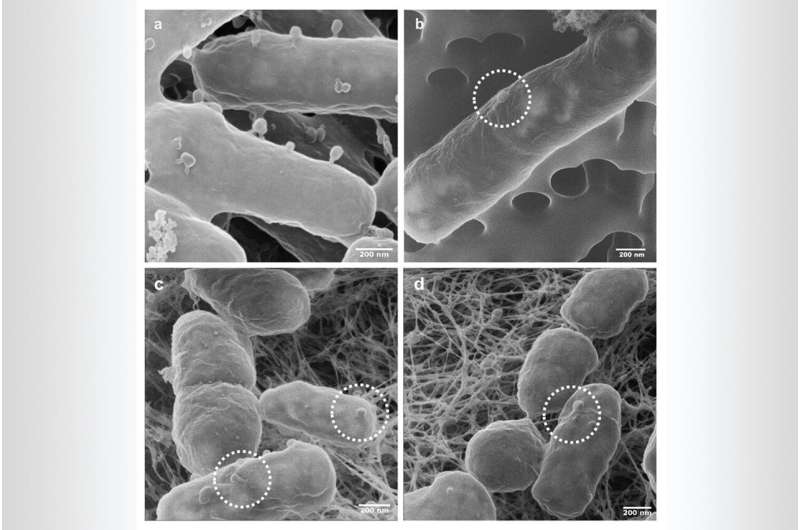Visualisation of the adsorption of phages on E. coli bacteria. Figure a) shows how phages infect host bacteria by attaching the ends of their tail fibres to the surface of the bacteria and injecting phage-specific nucleic acid into the host. Images b), c), and d) show that in order to “hitch a ride” on the bacteria, the phages nestle flat against them without penetrating them and remain infectious. Credit: UFZ / ISME Journal / CC BY 4.0
The interaction of fungi and bacteria in the transport of viruses in the soil ecosystem has been examined by a UFZ research team in a study recently published in The ISME Journal. The scientists showed a novel mechanism of viral transport by bacterial shuttles traveling along fungal hyphae. Bacteria thereby benefit from taking along viruses on the conquest of new habitats.
There are up to 1 billion viruses in just one gram of soil. However, little is known about their influence on the nutrient and carbon cycle in the soil ecosystem. Soils can sometimes be inhospitable places. Dry zones and air-filled soil pores are almost impossible obstacles for bacteria and viruses. In order for them to move around—for example, to get to a place with better conditions—they need water. But the situation is not completely hopeless. Because there is an excellently developed infrastructure in the soil: the fungal network. Fungi are always in search of water and nutrients. To do this, they form hyphae, long, thin threads that run through the soil as a widely branched network. Fungi are thus able to bridge dry and nutrient-poor zones.
In an earlier study, UFZ researchers showed that soil bacteria use the mucus-covered fungal hyphae in order to move around on them and thus reach new food sources. In their current study, the research team led by environmental microbiologist Dr. Lukas Y. Wick has now been able to identify another beneficiary of the underground fungal network. "Phages, i.e. viruses that have bacteria as their sole target, also travel this fungal highway," says Wick. "Not independently but rather by hitching a ride with bacteria. Physical forces cause the viruses to adhere to the surface of bacteria—much like mussels adhere to the hull of a ship." In this way, viruses hitch a ride through the soil—until they arrive at a place that is better suited for them. But what exactly is a good place for soil-dwelling viruses?
"Wherever the host bacteria of the viruses are found," says Wick. "Not every phage can infect every bacterium," says Wick. "Because of a kind of lock-and-key principle, phages can smuggle their genetic material only into their respective host bacteria." If this succeeds, the bacterium is reprogrammed to produce new phages. The bacterial cell then bursts, thereby releasing the phages of the next generation. These can then once again infect new host bacteria. "The phages are highly efficient at this. This obviously also gives the shuttle bacteria a real advantage," says Wick. "We were able to show that soil bacteria with phages attached to them were able to spread far better in their new location than bacteria without this viral baggage."
It is well known from macro-ecology that migratory species can cause problems for the established residents of a habitat. Also that invasive species can bring pathogens that increasingly contribute to the displacement of native species. The UFZ research group therefore interpreted their data using MAFIA (MAecological Framework of Invasive Aliens), a well-known model of invasion ecology. "With our fungus–bacteria–phage system, we were able to detect the same invasion patterns on a micro-scale as we did in the macro-ecological system," says Wick. "And because our microbial laboratory model can be quickly and easily sampled and modified, it could be used as a model system to answer various questions and hypotheses in invasion ecology—such as the transport of pests or pathogens."
For their studies, the research team recreated a micro-attack of bacteria and phages in the laboratory. For this purpose, two zones with culture medium were used. These were connected to each other only via fungal hyphae. "In Zone A, we used typical soil bacteria as shuttles as well as phages that cannot harm this bacterial species," explains Xin You, first author of the study and Ph.D. student at the UFZ Department of Environmental Microbiology. "Zone B was colonized with a phage-specific host bacterium." In different experimental approaches, the research team had the shuttle bacteria travel along the fungal hyphae highway with and without viral baggage. "The result was clear: the bacteria–phage duo had a clear advantage in the invasion of Zone B," says You. "The shuttle bacteria benefited from the power of the phages, which effectively disabled their host bacteria and thus also eliminated food competition for the invading bacteria."
"With our study, we were able to show for the first time that viruses are also transported in water-saturated ecosystems such as soil," says Wick. "Phages may have a great influence on the nutrient and carbon cycle there." But the soil is also central to plant growth, pollutant degradation, and the provision of drinking water. "The fact that the transport of phages obviously plays a significant role here may be relevant for future ecological questions or even biotechnological applications," says Wick.
More information: Xin You et al, Phage co-transport with hyphal-riding bacteria fuels bacterial invasion in a water-unsaturated microbial model system, The ISME Journal (2021). DOI: 10.1038/s41396-021-01155-x
Journal information: ISME Journal
Provided by Helmholtz Association of German Research Centres
























